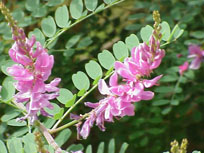
In its pure state indigo is a dark blue powder with a shimmer of coppery red. It does not dissolve in alcohol, and is soluble in water only with difficulty. In concentrated sulphuric acid it dissolves to yield a green colour, which becomes blue when heated. The indigo plant contains not indigo but indican, a yellow precursor of the colourant. Only after a series of chemical transformations does this highly colour-fast dye reveal its typical blue-jeans colour on textile materials.
True Indian indigo is obtainable on the market in cubes that are pressed into blocks. The dye can be obtained from various indigo plants:
| name | latin name | found in |
| Indigo Plant | Indigofera arrecta | Africa, today also found in India, Indonesia |
| Indigofera tinctoria | India, Asia, widespread today | |
| Indigofera suffruticosa | America, today also found in Africa, Asia | |
| Woad | Isatis tinctoria | Caucasus, Asia, later Europe |
History

Along with madder and mignonette, indigo is one of the oldest known plant dyes. The most ancient traces of it have been found in a French cave dating from the Stone Age. Cloth strips dyed with indigo have been found with Egyptian mummies from 2000 BC. The oldest written record is found in Caesar's De Bello Gallico: "All the Britons dye themselves blue with woad (vitrum), and so look quite terrifying in combat." A papyrus found in a Theban tomb dating from the 3rd or 4th century AD describes the process of making a dye from woad.
In Europe the "king of dyes" was obtained for many years from "dyer's woad", a flowering plant of the cruciferous family. Records from the 12th century show that woad was cultivated in Thuringia. The city of Erfurt became so rich from the woad trade that its profits formed the basis for the foundation of its university in 1392. Woad was cultivated on smallholdings in the rural districts around the city. Woad dealers purchased the raw plant materials from the farmers on the city markets and processed it to yield a coloured powder, which they in turn sold on to the dyers. Cities benefited from the tax on woad. The woad indigo that was produced in Thuringia was exported to Saxony or to Cologne, the city of cloth-merchants. By way of the Hanseatic ports of Hamburg, Lübeck and Bremen it eventually reached Holland and England.
With the foundation of the Dutch East India Trading Company in the year 1602, European indigo production was doomed. The Dutch seafarers started importing indigo from India. The Asian indigo plant was distinguished by its higher yield of pigment. This made the dye cheaper to produce. With a view to supporting the domestic woad trade, stringent decrees banning the import and processing of Indian indigo were issued. In Nuremberg dyers were even subject to the death penalty if they contravened the ban.
In the 17th century however, after a long struggle, Indian indigo established itself. The decisive factor was its higher content of colourant. In the year 1897 700,000 hectares were still dedicated to indigo cultivation in India, and the country's annual production was around 8000 tons.
The year 1878 marked a decisive turning point for the indigo trade, when the German chemist Adolf von Baeyer succeeded in producing synthetic indigo for the first time. In 1897 this synthetic indigo began to be marketed cheaply by Ludwigshafen-based BASF (Badische Anilin- und Sodafabrik - the Baden Aniline and Soda Factory). Today indigo is made by the "Heumann synthesis". Already in 1914 the market share of natural indigo had shrunk to 4%.